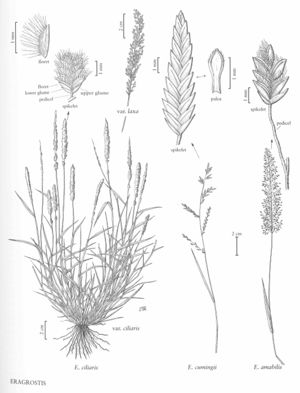Difference between revisions of "Eragrostis ciliaris"
FNA>Volume Importer |
imported>Volume Importer |
||
| (8 intermediate revisions by 2 users not shown) | |||
| Line 4: | Line 4: | ||
|publications= | |publications= | ||
|common_names=Gophertail lovegrass | |common_names=Gophertail lovegrass | ||
| + | |special_status={{Treatment/ID/Special_status | ||
| + | |code=I | ||
| + | |label=Introduced | ||
| + | }} | ||
|basionyms= | |basionyms= | ||
|synonyms= | |synonyms= | ||
| Line 17: | Line 21: | ||
-->{{Treatment/Body | -->{{Treatment/Body | ||
|distribution=Puerto Rico;N.J.;Ga.;Tex.;La.;Virgin Islands;Ala.;Pacific Islands (Hawaii);Miss.;S.C.;Fla. | |distribution=Puerto Rico;N.J.;Ga.;Tex.;La.;Virgin Islands;Ala.;Pacific Islands (Hawaii);Miss.;S.C.;Fla. | ||
| − | |discussion=<p>Eragrostis ciliaris is native to the paleotropics. It is naturalized in parts of the United States, growing along roadsides, on waste sites, in xerothermic vegetation, and sometimes in saline habitats, at 0-200 m. It may be more widespread than indicated.</p> | + | |discussion=<p><i>Eragrostis ciliaris</i> is native to the paleotropics. It is naturalized in parts of the United States, growing along roadsides, on waste sites, in xerothermic vegetation, and sometimes in saline habitats, at 0-200 m. It may be more widespread than indicated.</p> |
|tables= | |tables= | ||
|references= | |references= | ||
| Line 40: | Line 44: | ||
-->{{#Taxon: | -->{{#Taxon: | ||
name=Eragrostis ciliaris | name=Eragrostis ciliaris | ||
| − | |||
|authority=(L.) R. Br. | |authority=(L.) R. Br. | ||
|rank=species | |rank=species | ||
| Line 47: | Line 50: | ||
|basionyms= | |basionyms= | ||
|family=Poaceae | |family=Poaceae | ||
| + | |illustrator=Linda A. Vorobik;Cindy Roché | ||
| + | |illustration copyright=Utah State University | ||
|distribution=Puerto Rico;N.J.;Ga.;Tex.;La.;Virgin Islands;Ala.;Pacific Islands (Hawaii);Miss.;S.C.;Fla. | |distribution=Puerto Rico;N.J.;Ga.;Tex.;La.;Virgin Islands;Ala.;Pacific Islands (Hawaii);Miss.;S.C.;Fla. | ||
|reference=None | |reference=None | ||
|publication title= | |publication title= | ||
|publication year= | |publication year= | ||
| − | |special status= | + | |special status=Introduced |
| − | |source xml=https:// | + | |source xml=https://bitbucket.org/aafc-mbb/fna-data-curation/src/200273ad09963decb8fc72550212de541d86569d/coarse_grained_fna_xml/V25/V25_106.xml |
|subfamily=Poaceae subfam. Chloridoideae | |subfamily=Poaceae subfam. Chloridoideae | ||
|tribe=Poaceae tribe Cynodonteae | |tribe=Poaceae tribe Cynodonteae | ||
Latest revision as of 18:55, 11 May 2021
Plants annual; tufted, without innovations, without glands. Culms (3)9-75 cm, erect or geniculate in the lower portion, not rooting at the lower nodes, glabrous. Sheaths hairy on the margins and at the apices, hairs to 4 mm; ligules 0.2-0.5 mm; blades 1.8-12(15) cm long, 2-5 mm wide, usually flat, occasionally involute, glabrous or ciliate basally. Panicles 1.7-15 cm long, 0.2-5 cm wide, cylindrical, contracted or open, branches usually forming glomerate lobes, sometimes more open, often interrupted in the lower portion; primary branches 0.4-4 cm, appressed or diverging to 50° from the rachises; pulvini usually glabrous, occasionally sparsely pilose; pedicels 0.1-1 mm, erect, shorter than the spikelets, glabrous. Spikelets 1.8-3.2 mm long, 1-2 mm wide, elliptical-ovate to ovate-lanceolate, yellowish-brown, sometimes with a purple tinge, with 6-11 florets; disarticulation basipetal, glumes peristent. Glumes ovate to lanceolate, keels scabridulous, veins commonly green, apices acute; lower glumes 0.7-1.2 mm; upper glumes 1-1.6 mm; lemmas 0.8-1.3 mm, elliptical-ovate to lanceolate, membranous, keels scabridulous, lateral veins evident, apices obtuse to acute; paleas 0.8-1.3 mm, membranous, keels prominently ciliate, cilia 0.2-0.8 mm, apices obtuse to acute; anthers 2, 0.1-0.3 mm, purplish. Caryopses 0.4-0.5 mm, ovoid, reddish-brown. 2n = 20, 40.
Distribution
Puerto Rico, N.J., Ga., Tex., La., Virgin Islands, Ala., Pacific Islands (Hawaii), Miss., S.C., Fla.
Discussion
Eragrostis ciliaris is native to the paleotropics. It is naturalized in parts of the United States, growing along roadsides, on waste sites, in xerothermic vegetation, and sometimes in saline habitats, at 0-200 m. It may be more widespread than indicated.
Selected References
None.
Key
| 1 | Panicles 0.2-1.5 cm wide, contracted, the branches mostly appressed to the rachises, congested, forming glomerate lobes; spikelets densely packed | Eragrostis ciliaris var. ciliaris |
| 1 | Panicles 1.5-5 cm wide, open, the branches spreading 20-50° from the rachises; spikelets widely separated from each other | Eragrostis ciliaris var. laxa |
